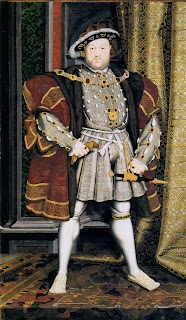Head to Toe: A Tudor Man
8:46 AMIn the early sixteenth century, men were all about width. Their wardrobe emphasized and enhanced the width of the body, giving a very powerful presence. In today's head to toe post, we'll find out how this look was created.
 | ||
| Portrait of Henry VIII, after Hans Holbein the Younger, c. 1537. In the collection of the Walker Art Gallery. |
Henry's basic foundation garment is a white shirt, the collar and cuffs of which can be seen in his painting. Little puffs of undershirt are also visible in the slashing which decorates his outer garments. Over the shirt he wears a doublet, a waist length, tightly fitted garment which opened down the center front. Doublets could be elaborately decorated with slashing and jewels, as can be seen in this image.
On top of the doublet is a jerkin. The jerkin fit over the waist like a vest, with a deep V or U shaped neckline. Below the waist, the jerkin flared out into a skirt. It's a little difficult to differentiate between Henry's jerkin and doublet, but the image below better illustrates the idea. The Ambassador to the left wears a pink doublet and black jerkin.
 | ||
| The Ambassadors by Hans Holbein the Younger, c. 1533. In the collection of the National Gallery, London. |
The bulky overcoat worn over the doublet and jerkin is a box coat, so called because it's shaped like a box. Often stuffed with straw to give volume, the box coat featured huge sleeves which gave men a wide and powerful silhouette. Often they were lined in fur, as can be seen in both images (Henry's box coat is lined in brown fur, while the Ambassador's coat is lined with white).
The legs were covered with hose, which had become two separate pieces. Upper stocks covered the top half of the leg, while lower stocks covered the bottom. The differentiation between the two pieces is particularly clear in Henry's portrait. The emphasis on width is continued all the way down to the shoes, called duckbill shoes. Duckbill shoes were flat and square in front, made of leather, and could be slashed for decoration.



2 comments